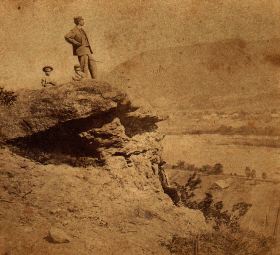
Table Rock: circa 1870
On this excursion into the Connecticut River Valley the goals were more hiking and historic rather than geologic, although the latter is most always inescapably tied in to all I do. Making my way up the old mountain road, I set off to search for Paradise and the Garden of Eden. These names were very much tied to a section of mountain terrain and already in use by the late 1860's where I came across the first written reference. My journey took me over old Kellogg Hill (another archaic name) to one of the Valley's finest vistas - or "prospect" as they use to say. At one site I passed at least a half dozen conglomerate erratics - not native to this immediate area - strewn about as if it were the playground of the Gods - perhaps the Titans. One boulder carried the weight of two trees growing upon its top surface. This whole are is set back above a magnificent escarpment with Paradise - and its beautiful ravine - being it's northern boundary. Finally turning back - and upward - I climbed up into a commanding length of conglomerate ledge where one Giant's face of stone peered down upon me. Making my way the mountainside to my car I regrouped to head into the Garden of Eden. Also setback from a lengthy escarpment the old site likely existed with in cirque - or corrie - several of which exist in this area carved out by the glaciers of long ago. Eventually I passed an outlook with an old survey station marker and reached a spring fed swamp located within the top portion of a double cirque. The outlet for this marvel of nature is a stream that leaps over the escarpment forming a superb cascade. On the return to my car, I did some checking into the walls of the cirques where a partially buried stone wall spoke of times long ago forgotten. The way home - I took the lazy man's approach to Sugarloaf whose road is now open for the season. King Philip's Seat/Lookout, or Table/Jutting Rock as it is sometimes know, has been fenced off for years and views of it mostly hidden by foliage.
